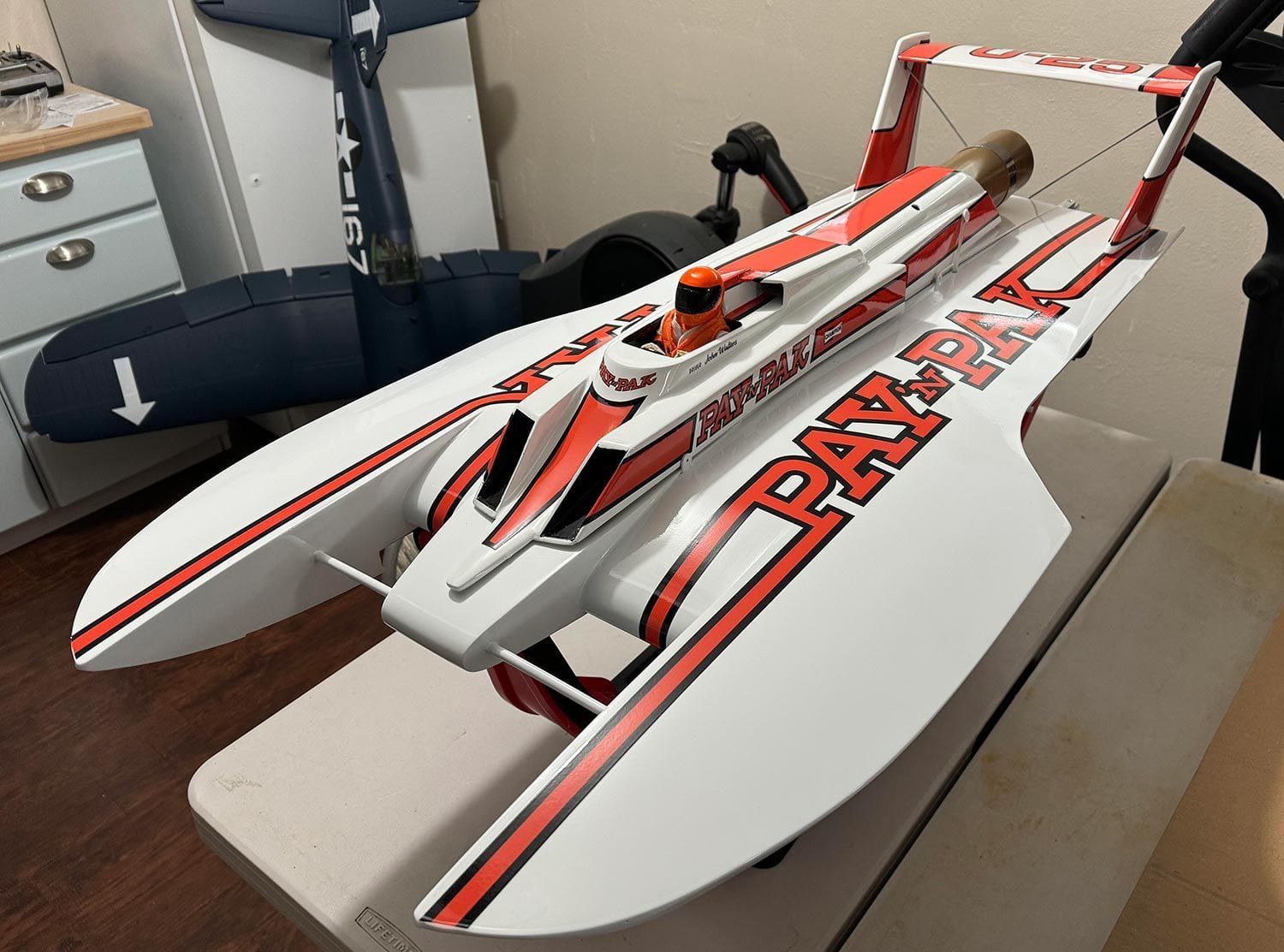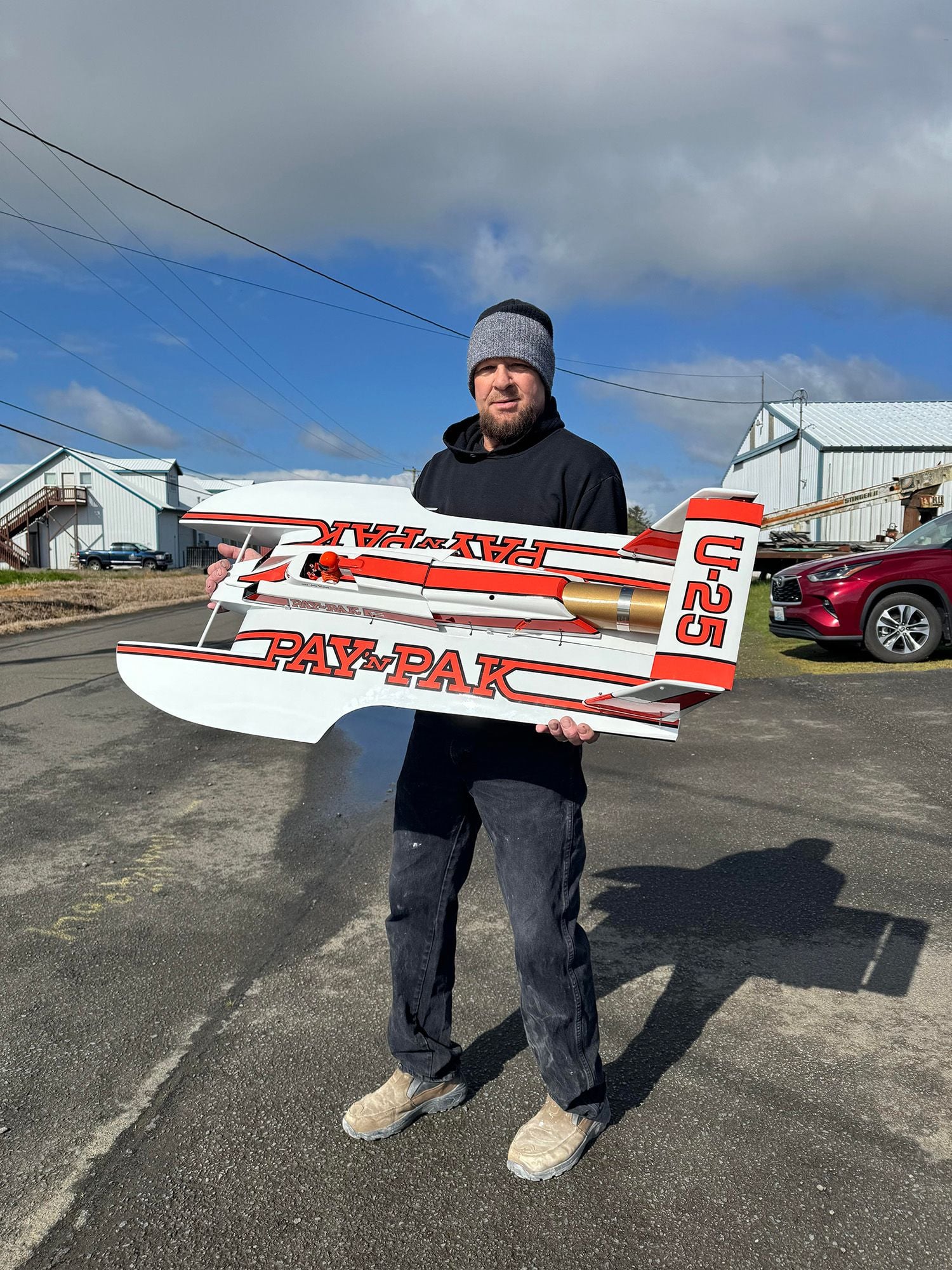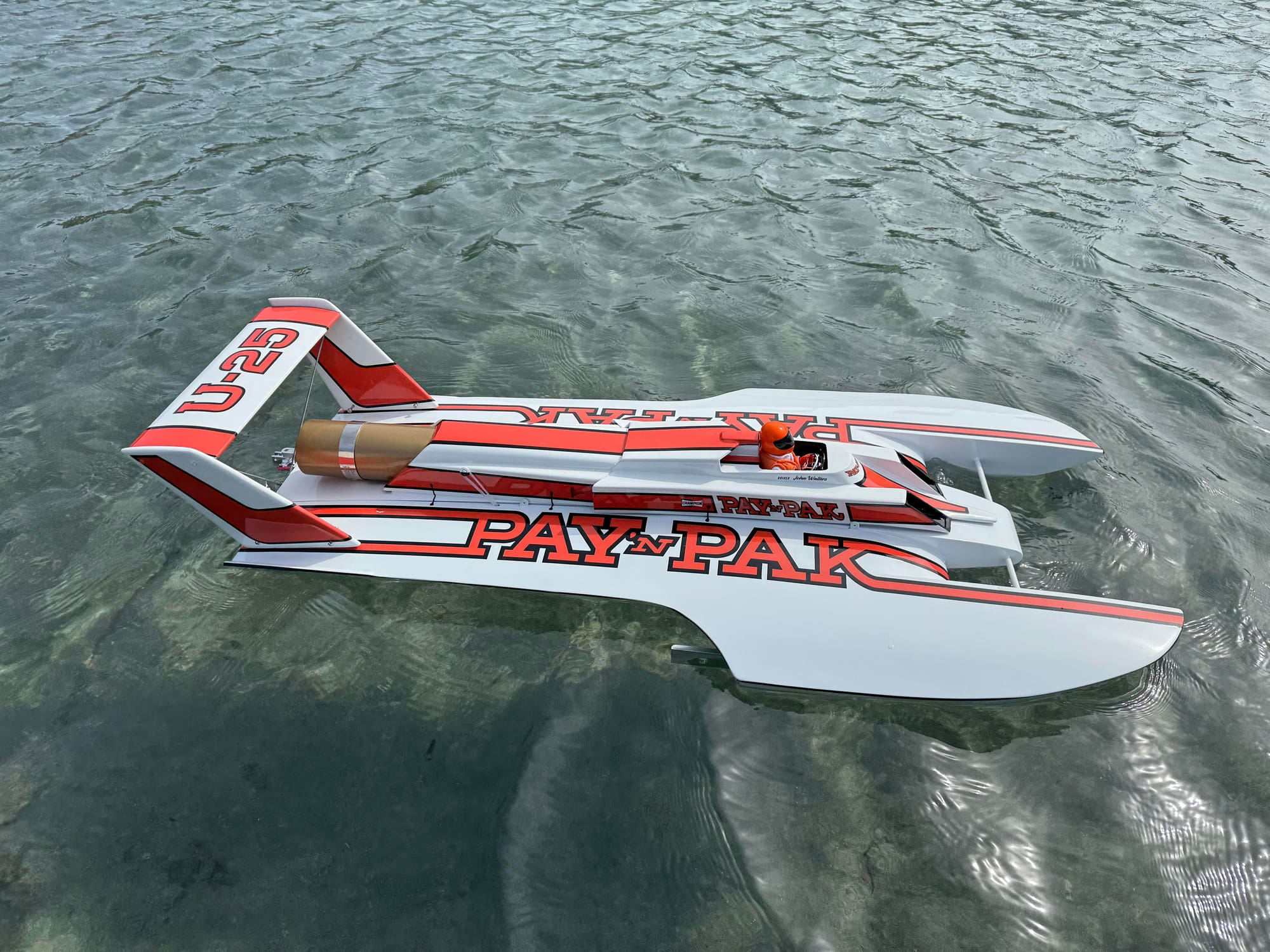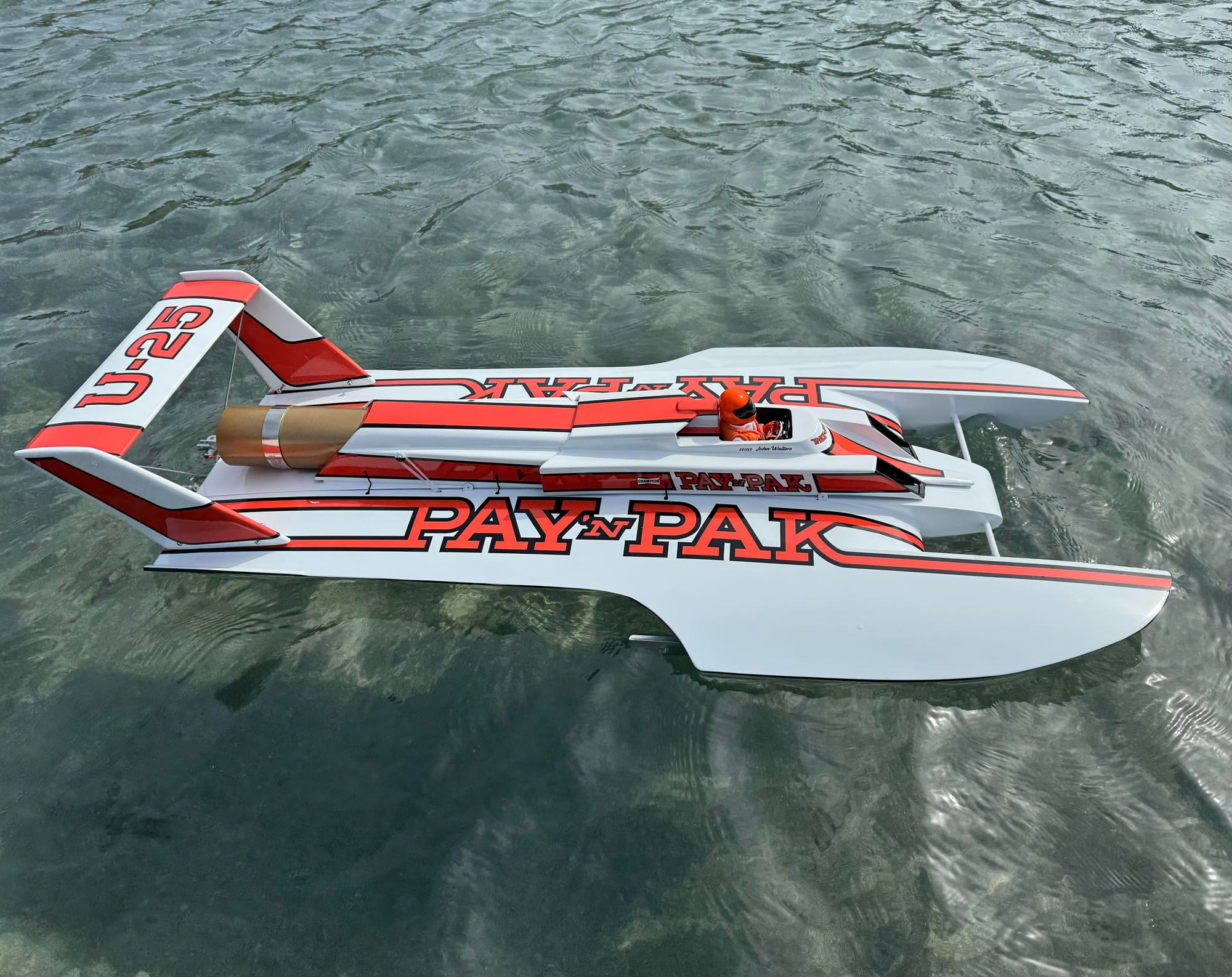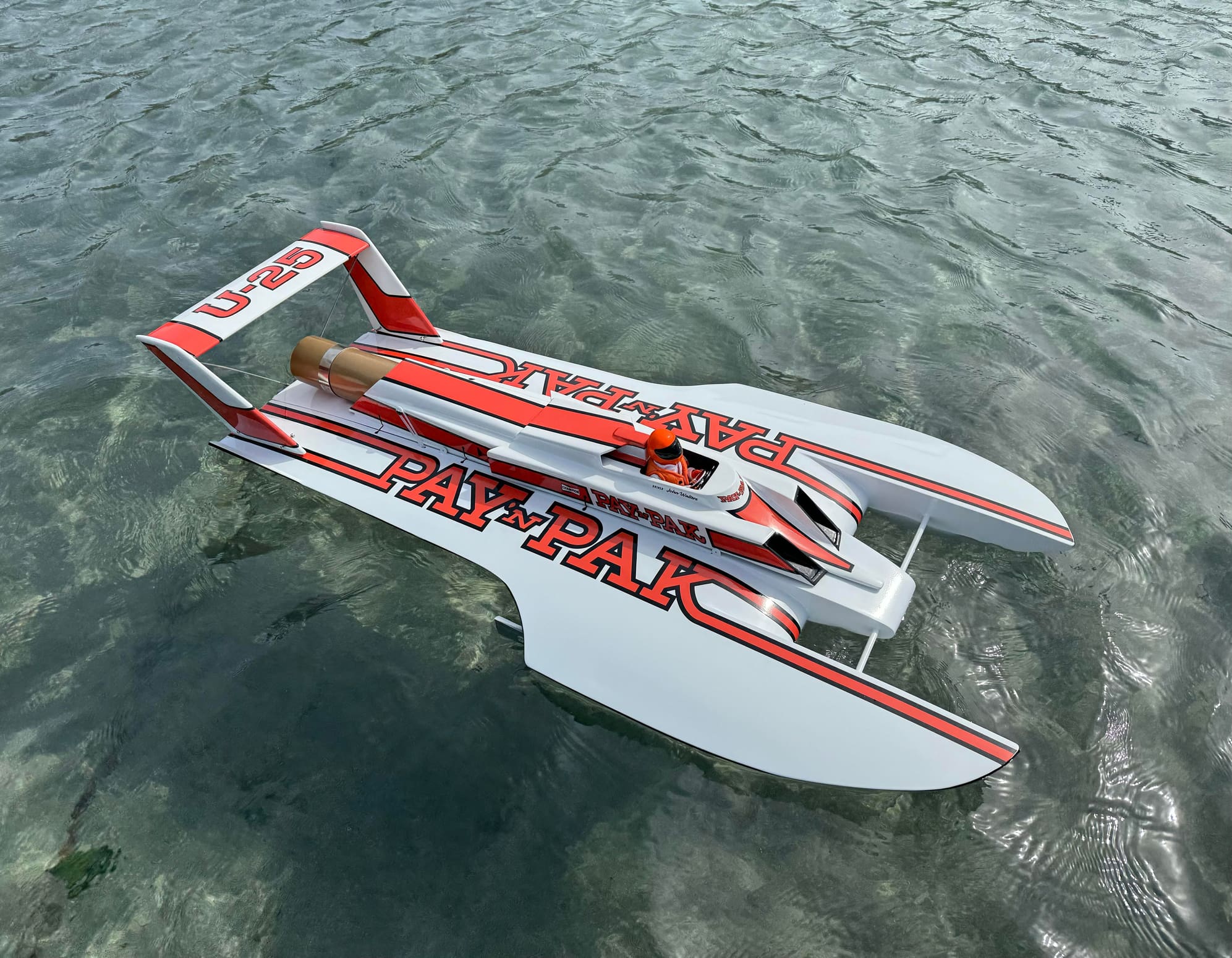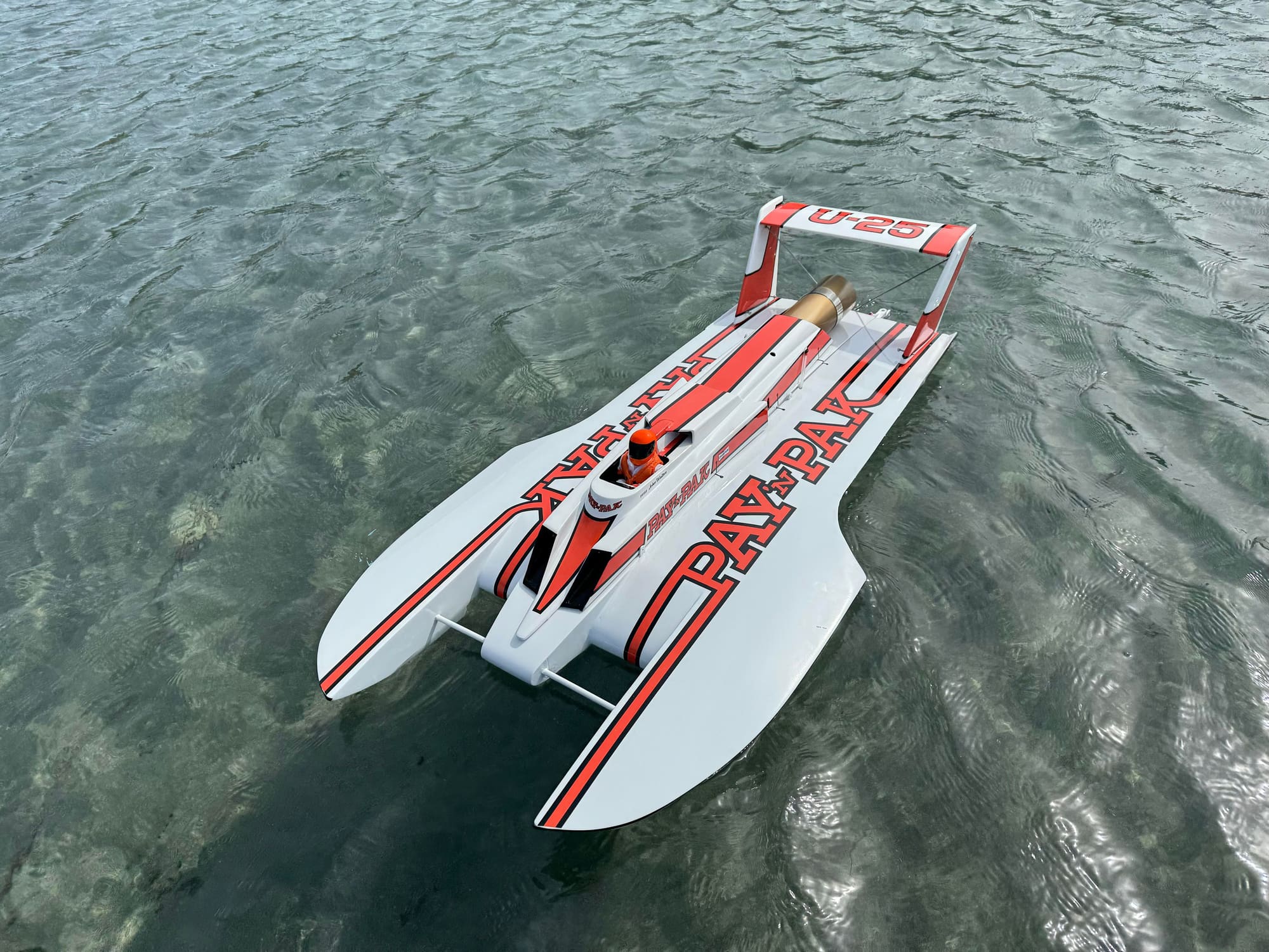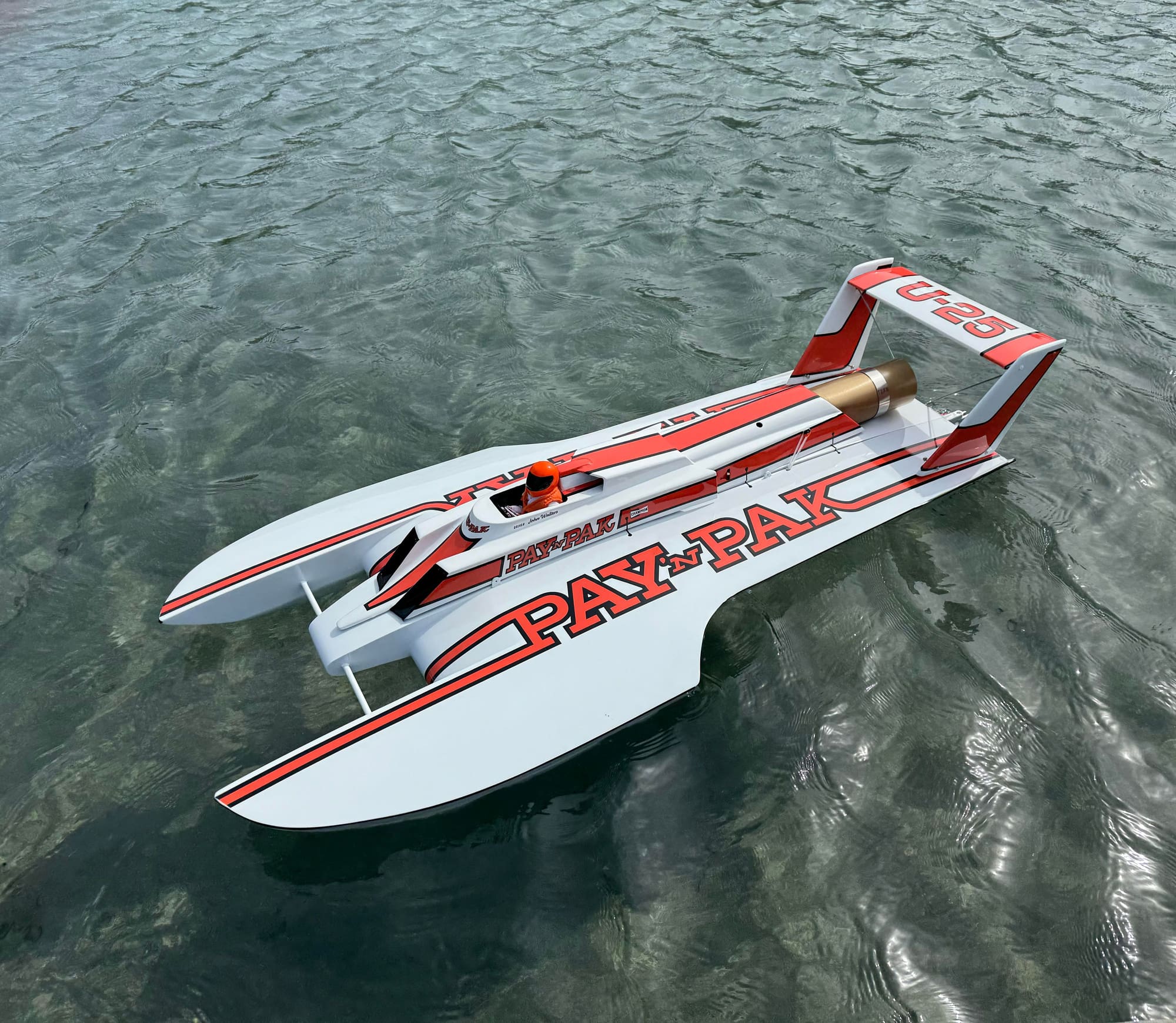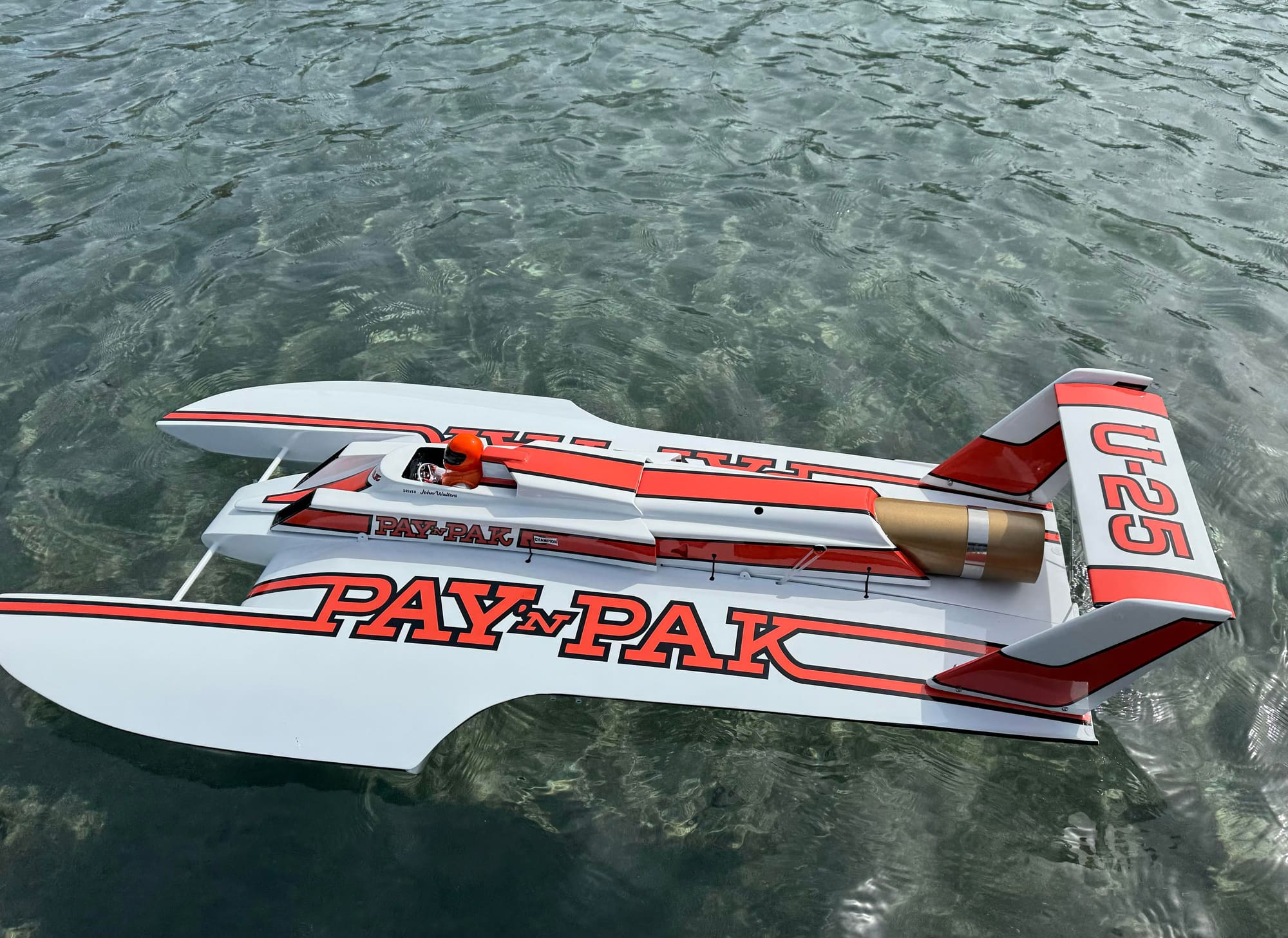Anyone Into 1/8 Scale Unlimited Hydros?
#51

My Feedback: (10)
I carry my same "more $$ =/= better" methodology into airplanes too... I'm an EdgeTX/Radiomaster guy.
You don't necessarily need a waterproof RX, but you should have the RX in a waterproof radio box, or you can do like some people, and wrap it in something waterproof. Balloons are popular, as are non-lubricated condoms! All of my boats have the RX's in a waterproof radio box, but I keep a few condoms in my field box just in case.
And really, wheel/surface type radios are obviously more popular with boat guys (myself included), but you could also use your plane TX if you wanted to. I've driven boats with my stick type TX, and don't really care for it as I find wheel radios more intuitive, but if you've already got it, there's no reason you can't use it. Just pick up a cheap 2/3/4 channel Spektrum RX and you'd be good to go.
You don't necessarily need a waterproof RX, but you should have the RX in a waterproof radio box, or you can do like some people, and wrap it in something waterproof. Balloons are popular, as are non-lubricated condoms! All of my boats have the RX's in a waterproof radio box, but I keep a few condoms in my field box just in case.
And really, wheel/surface type radios are obviously more popular with boat guys (myself included), but you could also use your plane TX if you wanted to. I've driven boats with my stick type TX, and don't really care for it as I find wheel radios more intuitive, but if you've already got it, there's no reason you can't use it. Just pick up a cheap 2/3/4 channel Spektrum RX and you'd be good to go.
#52
I have to agree with JS on what radio type to use with a boat. I tried to use my Futaba 9CAP in my Elam, just couldn't get the hang of it. Went out and bought a Futaba 4PLS wheel radio and it was a night and day difference.
As far as what receiver to use, I've found there isn't really any such thing as a "waterproof" one, or servo for that matter. A better term would be "water resistant" since water will find its way into anything eventually. Since you're really only looking at a one channel boat, that being the rudder, you need to be sure to use a servo for it in the 200+ inch ounce range with a battery pack that can put out enough juice to handle the load. I know, you're saying " What about the ESC for throttle control?" I tend to look at a channel as something that's controlled by a servo and linkage. An ESC normally doesn't take nearly as much power as a servo since its activation is all electronic in nature
As far as what receiver to use, I've found there isn't really any such thing as a "waterproof" one, or servo for that matter. A better term would be "water resistant" since water will find its way into anything eventually. Since you're really only looking at a one channel boat, that being the rudder, you need to be sure to use a servo for it in the 200+ inch ounce range with a battery pack that can put out enough juice to handle the load. I know, you're saying " What about the ESC for throttle control?" I tend to look at a channel as something that's controlled by a servo and linkage. An ESC normally doesn't take nearly as much power as a servo since its activation is all electronic in nature
#54
I saw the servo, didn't know which one it was or how much power it has so I figured it's better to say something than to have him end up with a handling issue. I had a rudder issue with my Elam back in 2014, couldn't get it to turn at over half throttle. Found out it was the rudder linkage putting a heavier than it should have load on the rudder servo. To remedy the issue, I went from a 125 inch ounce servo to a 300, problem solved
#55

Thread Starter
Thanks again for the great info both of you, I really appreciate it. Honestly I don't even know what servo that is as the builder installed it. I'll have to ask him what it is. I am definitely going to go with a wheel radio for sure.
#56
If your rudder servo is like most on the market, it will have a manufacturer's name and number somewhere around the top of the servo. If you can find that information, you can google it and find out the major specs of the servo.
I am going to suggest three features you need to consider if you're going to buy a wheel radio:
I am going to suggest three features you need to consider if you're going to buy a wheel radio:
- Multi-model memory. This will make it less expensive to have multiple boats since you won't have to buy anything beyond receivers and servos. That can, over time, save you a lot of money
- EPA. Since you fly, you know the value of this feature already
- Servo Speed Adjustment. This one I've found to be invaluable and the following will tell you why. When I first started racing my Elam, I had problems with turning the boat too fast. This resulted in missed buoys and spinning out the boat. Since I was using my Futaba 9CAP to handle the boat, I figured it was an issue with me using a stick radio. This got me to thinking a wheel radio would be the solution so I bought a Futaba 4PLS. Ironically, I had the same issues for several races I attended, until I spun out in front of another boat. Fortunately for me, the other driver knew I'd been having issues and was able to avoid my boat and, following the heat, came over and started checking out my boat. Initially, he found nothing to cause my handling issues and then he started playing with the radio. What he found, initially, was the rudder was swinging too far both ways. He took me over to his boat and showed me that his rudder was swinging about half as far to the right and only a third as far to the left. After going back to my boat and a running through the radio's owner's manual, he reset my end points for the rudder. Since he wasn't racing in the same heat as me in the next round, he was my co-driver. While my boat was less of a handful to drive, it was still too quick when turning, again leading to cut buoys. The next heat, he was racing, so I watched how differently his boat turned when compared to mine. The heat ended and, after taking care of his boat, we started looking at mine again. First step was to reduce the right rudder swing a bit more. Next, he took my manual and started going through it with a fine toothed comb. After about ten minutes, he gave a loud "I FOUND IT!!!!" followed by an "I knew it had to have it". Not knowing what he was talking about, several of us just stared at him, waiting for an explanation. It took him a minute while he did a bit more reading and then said "We need to slow down your rudder". Part of the guys went back to their boats while some of the others asked him what he was talking about. Come to find out, my radio had a servo speed adjustment that I didn't know about or, for that matter, how to use. He explained to me that my rudder servo has a very quick swing, in this case 60 degrees in .17 seconds at 6VDC. I run a 4.8VDC receiver pack so it was a bit over .2 seconds but still very quick for a 60 degree swing that had now been reduced to around 30 due to the reset end points. He took the boat, propped the rear up on the prop guard, and started turning the rudder back and forth while noting how fast it moved. Next, he went into the transmitter menu and found the servo speed setting adjust and slowed it down to 50%. With all of this done, we waited for the next heat where, like the previous one, he was my co-driver. This time, I had no issues in cutting buoys but I also couldn't make the turn in the inside lanes. A slight tweak in the right rudder throw to tighten it up a touch and all was good in the last heat I ran that day. IF you're familiar with a servo speed adjust from radios you've had, then my little story was a waste of time. If you haven't had it or used it, it can make a world of difference in how your boat handles
Last edited by Hydro Junkie; 10-20-2023 at 07:44 AM.
#57

Thread Starter
Fantastic info! Yes I am familiar with servo speed adjustments but it's excellent info for me to consider once I am setup and RTR. At the moment I plan on taking it out on the water solo but I might get the bug to join a club once I get prolific with handling.
I did find out the servo...It is a ProModeler DS555BLHV. Looks like it is discontinued but was around $110 retail at the time. Hopefully it's robust enough for my needs? https://www.promodeler.com/DS555BLHV
I did find out the servo...It is a ProModeler DS555BLHV. Looks like it is discontinued but was around $110 retail at the time. Hopefully it's robust enough for my needs? https://www.promodeler.com/DS555BLHV
#58
I found a bit of information on that servo, some good and some not so much:
- Note: operating voltage is 4.8-8.4V, but optimal performance is obtained with a 2S LiPo instead of a BEC. This is because LiPos deliver the required current without voltage spikes, noise, or otherwise adversely affecting the delicate avionics (25C or better is recommended). After all, synthetic orange colored Tang may have gone to the moon, but it doesn't compare to freshly squeezed orange juice. Same thing when it comes to feeding your avionics!
- Q. Is it normal for the ProModeler DS470 to get fairly warm, almost hot to the touch, after 25-30 min of crawling? I set my endpoints after I first installed making sure no binding was occurring.
- A. If there is no binding, no problem . . . and yes, it's going to get hot - of course! For example, depending on how hard it's working you may be dissipating 35W, maybe more. Ever touched a 35W light bulb? Burned your finger, right? The formula for power is W=V*A so plug in for Voltage, make an educated guess on Amperage (if you don't have an inline meter), then solve for Watts. Presto, you get a lot of heat! The point is, you can't get 470oz-in of force without a lot of power. Power means heat. Always has, always will.
- It weighs 83 grams The Futaba S9056 digital servo I use in my Elam weighs only 63 grams
- At 6VDC your servo will give 415 inch ounces of torque, which is serious overkill. My lighter S9056 will give me 340.3, still overkill but not as much.
- For the specs, check here; https://www.promodeler.com/DS555BLHV
Last edited by Hydro Junkie; 10-20-2023 at 09:24 AM.
#59

Thread Starter
Hmm, I will have to ask the builder why he chose that particular servo. If I should upgrade I am all for it. The last thing I want is to ruin the boat over a $100 discontinued servo. Any recommendations?
And I am still looking for what LiPo(s) to use for that motor/ESC combo. This is where I wish I had more experience with electrical setups. I am a PNP/RTR kind of guy. I don't even know if my power system is for a 6S/8S/12S setup? Nobody I've reached out to has been able to tell me definitively yet.
And I am still looking for what LiPo(s) to use for that motor/ESC combo. This is where I wish I had more experience with electrical setups. I am a PNP/RTR kind of guy. I don't even know if my power system is for a 6S/8S/12S setup? Nobody I've reached out to has been able to tell me definitively yet.
#60

My Feedback: (10)
ProModeler servos are great units.
I've never had one get warm (but have never ran that specific servo), but unless it gets HOT, it's extremely unlikely that the heat will soften the epoxy enough to break it loose. Even general purpose epoxy is surprisingly tolerant of heat. In crawling, your tires are often very bound and the servo is working very hard. These boats don't require nearly as much torque, and unless you're using a servo that's WAY underkill, the water is almost certainly not going to bind it up. Not to mention, you aren't going to be running for 25-30 minutes at a time. How long does a battery/race last? Maybe 5 -10 minutes tops?
As for waterproofing (Hydro), the ESC and motor should both be waterproof obviously, so there's no need to seal it up tight. Batteries don't have a problem getting wet. Hell, I've got an electric jet boat that I run without a hatch, exclusively in salt water. The batteries are regularly doused in salt water, and then at the end of the day I literally hose out the inside of the boat... motor, ESC, batteries, and servos (RX in a "water tight" box) to clean off the salt. Been doing it that way for a few years now with the same 2 batteries, never a problem.
I've never had one get warm (but have never ran that specific servo), but unless it gets HOT, it's extremely unlikely that the heat will soften the epoxy enough to break it loose. Even general purpose epoxy is surprisingly tolerant of heat. In crawling, your tires are often very bound and the servo is working very hard. These boats don't require nearly as much torque, and unless you're using a servo that's WAY underkill, the water is almost certainly not going to bind it up. Not to mention, you aren't going to be running for 25-30 minutes at a time. How long does a battery/race last? Maybe 5 -10 minutes tops?
As for waterproofing (Hydro), the ESC and motor should both be waterproof obviously, so there's no need to seal it up tight. Batteries don't have a problem getting wet. Hell, I've got an electric jet boat that I run without a hatch, exclusively in salt water. The batteries are regularly doused in salt water, and then at the end of the day I literally hose out the inside of the boat... motor, ESC, batteries, and servos (RX in a "water tight" box) to clean off the salt. Been doing it that way for a few years now with the same 2 batteries, never a problem.
The following users liked this post:
Aros (10-20-2023)
#62
I just know what the guys that run electrics at our races do and that is to seal up the hull, normally with a clear lexan or thin plastic sheet, taped down, to keep the electronics dry. As for the heat issue, I get that the guy asking the question is using it in a different application but, in that application, it is exposed to air that can move. If it is getting so hot that it could burn the fingers in the way the person answering the question stated, in an open air environment, it would have me doing some serious testing to see just how hot it actually gets. As far as how long a race lasts, using twin 8S packs, the average time is 60-90 seconds of pre-race milling, depending on the driver, followed by 5-7 laps around the course, the number being determined on whether there are any penalty laps assessed. If no penalties are assessed, the race will cover about a mile over 5 laps
#67
This is right out of the R/C Unlimiteds FE rulebook:
3. Batteries
a. A maximum capacity of 8S Lithium Polymer (LiPo) batteries are approved. Only LiPo batteries with a cell rating of 4.20 or less volts per cell are approved. Maximum charged voltage is 33.84 volts.
b. LiHV batteries with per cell capacities to 4.35 volts or higher are not approved.
With that all said, I think they stay in the same range as you have in your planes
3. Batteries
a. A maximum capacity of 8S Lithium Polymer (LiPo) batteries are approved. Only LiPo batteries with a cell rating of 4.20 or less volts per cell are approved. Maximum charged voltage is 33.84 volts.
b. LiHV batteries with per cell capacities to 4.35 volts or higher are not approved.
With that all said, I think they stay in the same range as you have in your planes
The following users liked this post:
Aros (10-26-2023)
#68

Thread Starter
Latest updates. The cowl and tail parts are painted and decals added. The hull is about to be painted this week. All parts will be clear coated soon. Happy with the results so far!






